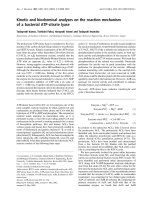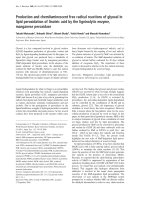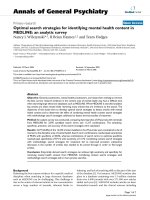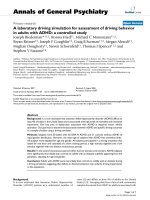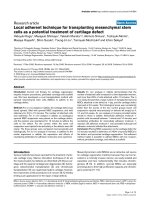Báo cáo y học: "Omentoplasty and Thoracoplasty for treating postpneumonectomy bronchopleural fistula in a patient previously submitted to aortic prosthesis implantation" doc
Bạn đang xem bản rút gọn của tài liệu. Xem và tải ngay bản đầy đủ của tài liệu tại đây (203.53 KB, 3 trang )
BioMed Central
Page 1 of 3
(page number not for citation purposes)
Journal of Cardiothoracic Surgery
Open Access
Case report
Omentoplasty and Thoracoplasty for treating postpneumonectomy
bronchopleural fistula in a patient previously submitted to aortic
prosthesis implantation
Mario Nosotti*
1
, Ugo Cioffi
1,2
, Matilde De Simone
1,2
, Paolo Mendogni
1
,
Alessandro Palleschi
1
, Lorenzo Rosso
1
, Michele M Ciulla
3
and
Luigi Santambrogio
1
Address:
1
Department of Surgery-Thoracic and Transplant Unit, Fondazione IRCCS Ospedale Maggiore Policlinico, Milano; Università degli Studi
di Milano, Milan, Italy,
2
Department of Surgery, Fondazione IRCCS Ospedale Maggiore Policlinico, Milano; Università degli Studi di Milano,
Milan, Italy and
3
Department of Respiratory and Cardiovascular Disease, Fondazione IRCCS Ospedale Maggiore Policlinico, Milano; Università
degli Studi di Milano, Milan, Italy
Email: Mario Nosotti* - ; Ugo Cioffi - ; Matilde De Simone - ;
Paolo Mendogni - ; Alessandro Palleschi - ; Lorenzo Rosso - ;
Michele M Ciulla - ; Luigi Santambrogio -
* Corresponding author
Abstract
Bronchopleural fistula following pneumonectomy is a serious and frightening complication in chest
surgery with a high mortality rate. The possibility of curing this complication using a conservative
treatment is extremely poor. Below we describe a case of a patient affected by left pleural
empyema due to a postpneumonectomy bronchopleural fistula. The patient had previously
undergone an aortic prosthesis implantation. He was successfully treated using omental pedicle in
order to cover the bronchial stump, to fill the pleural space and to protect the aortic prosthesis.
He also underwent thoracoplasty to collapse the residual pleural space. The postoperative course
was uneventful. During the follow-up, after thirty months, the patient was asymptomatic, and no
recurrence of the fistula was present.
Background
Bronchopleural fistula (BPF) is a serious and frightening
complication of pulmonary surgery with a high mortality
rate [1]. Different methods have been used to close the fis-
tula; from conservative treatment such as bronchial gluing
or stent placement [1], to surgical management [2,3].
We report a case of postpneumonectomy BPF successfully
treated using omental pedicle and thoracoplasty in a
patient with previously aortic prosthesis implantation.
Case presentation
In August 2006, a 39-year old man was referred to our
department for pleural empyema resulting from a large
left main bronchus fistula two months after pneumonec-
tomy. Twenty years before the patient had undergone to
aortoplasty with a Dacron patch reconstruction for isth-
mic aortic stenosis, followed by two thoracotomies for a
hemothorax. In July 2006, the patient underwent an
aneurysmectomy and prosthesis aortic implantation
using a Gelweave™ vascular prosthesis (Terumo Vascutek,
Published: 24 July 2009
Journal of Cardiothoracic Surgery 2009, 4:38 doi:10.1186/1749-8090-4-38
Received: 7 April 2009
Accepted: 24 July 2009
This article is available from: />© 2009 Nosotti et al; licensee BioMed Central Ltd.
This is an Open Access article distributed under the terms of the Creative Commons Attribution License ( />),
which permits unrestricted use, distribution, and reproduction in any medium, provided the original work is properly cited.
Journal of Cardiothoracic Surgery 2009, 4:38 />Page 2 of 3
(page number not for citation purposes)
Renfrewshire, Scotland, UK) for isthmic aortic aneurysm
at the Department of vascular surgery of another hospital.
During the operation a left pneumonectomy was under-
taken for uncontrolled bleeding drug induced. In the early
postoperative period the patient was submitted to two
additional re-thoracotomies for serious recurrent left
hemothorax. A few days later, the patient presented with
fever, chills, malaise, leucocytosis, and purulent pleural
fluid from the chest tube due to empyema secondary to
the bronchopleural fistula. The patient was transferred to
our department. A flexible bronchoscopy revealed the
palsy of the left vocal cord due to recurrent laryngeal nerve
injury, and a large dehiscence of the left main bronchial
stump in the medial portion. A chest CT scan revealed a
left empyema and the hyperinflation of the right lung (fig.
1). Firstly, we tried to treat the fistula conservatively using
endobronchial apposition of biological glue, and daily
pleural antibiotic irrigation until the microbiological
assays on pleural fluid became negative. As the patient's
general condition had improved, we decided to carry out
a surgical treatment. The greater omentum was mobilized
from the greater curve of the stomach, through a median
laparotomy supported by the left gastroduodenal artery.
Subsequently, a left posterolateral thoracotomy was per-
formed. The bronchial stump showed almost complete
dehiscence. After the removal of infected and necrotic tis-
sue using sharp debridement and pulsed lavage, the pleu-
ral space was filled with antibiotic solution, and the well
vascularized pedicle of the greater omentum was trans-
posed into the left hemithorax through the central tendon
of the diaphragm. The omental flap was fixed onto the
bronchial stump using interrupted sutures and biological
glue. Subsequently, we performed a thoracoplasty by
resection from the 3
rd
to the 8
th
rib. The collapse of the
chest wall, including the parietal pleura and intercostal
muscles, led to a complete and well-made obliteration of
the residual pleural space. A chest tube and a subcutane-
ous drainage were placed and the thoracic incision was
sutured. Finally, an abdominal aspirative drainage was
inserted and the laparotomy was closed.
The postoperative course was uneventful and the patient
was discharged in general good condition 21 days after
surgery. A flexible bronchoscopy revealed no recurrence of
bronchopleural fistula at 6 and 12 months. A CT, carried
out at the same time, showed a complete obliteration of
the residual pleural space (fig. 2). After thirty months fol-
low-up no recurrence of the fistula was present.
Conclusion
Drainage of the infected pleural space, antibiotics to treat
infection, and accurate clearance of secretions from the
remaining lung should be the initial treatment modality
in Stage 1 disease [4,5]. Once the infection is under con-
trol, several surgical techniques can be considered in order
to cure BPF ranging from omentoplasty, pedicled pericar-
dial fat or pleural flap, myoplasty, thoracoplasty [5]. In
our patient we considered the omentoplasty to cover the
bronchial stump and to protect the aortic prosthesis, and
thoracoplasty to collapse the left pleural space and to con-
trol the underlying inflammatory process.
In complex subset we believe that omentoplasty is a relia-
ble approach when attempting to close bronchopleural
fistula as also reported by other authors [2,3], since the
omentum has the ability to function in the established
Axial CT scan (window setting) shows air-liquid level and bronchopleural fistula (white arrows)Figure 1
Axial CT scan (window setting) shows air-liquid level
and bronchopleural fistula (white arrows). The aortic
prosthesis is covered by purulent pleural fluid (black arrow).
Axial contrast enhanced CT shows the remodelling osteomuscular wall of the thoracic cage with a collapse of left pleural spaceFigure 2
Axial contrast enhanced CT shows the remodelling
osteomuscular wall of the thoracic cage with a col-
lapse of left pleural space.
Publish with BioMed Central and every
scientist can read your work free of charge
"BioMed Central will be the most significant development for
disseminating the results of biomedical research in our lifetime."
Sir Paul Nurse, Cancer Research UK
Your research papers will be:
available free of charge to the entire biomedical community
peer reviewed and published immediately upon acceptance
cited in PubMed and archived on PubMed Central
yours — you keep the copyright
Submit your manuscript here:
/>BioMedcentral
Journal of Cardiothoracic Surgery 2009, 4:38 />Page 3 of 3
(page number not for citation purposes)
infected area demonstrated by its natural role in the abdo-
men [4]. To our knowledge, the case reported is the first in
English literature because of the presence of a non-cov-
ered aortic prosthesis in an infected pleural cavity, with a
very high risk of infection and rupture of the prosthesis.
Consent
Written informed consent was obtained from the patient
for publication of this case report and any accompanying
images. A copy of the written consent is available for
review by the Editor-in-Chief of this journal.
Competing interests
The authors declare that they have no competing interests.
Authors' contributions
All authors read and approved the final manuscript.
References
1. Ferraroli GM, Testori A, Cioffi U, De Simone M, Alloisio M, Galliera
M, Ciulla MM, Ravasi G: Healing of Bronchopleural fistula using
a modified Dumon stent: a case report. J Cardiothorac Surg 2006,
1:16.
2. Martini G, Widmann J, Perkmann J, Steger K: Treatment of bron-
chopleural fistula after pneumonectomy by using an omental
pedicle. Chest 1994, 105(3):957-9.
3. Yokomise H, Takahashi Y, Inui K, Yagi K, Mizuno H, Aoki M, Wada H,
Hitomi S: Omentoplasty for postpneumonectomy bronchop-
leural fistulas. Eur J Cardiothorac Surg 1994, 8(3):122-4.
4. Molnar TF: Current surgical treatment of thoracic empyema
in adults. Er J Cardiothorac Surg 2007, 32:422-30.
5. Puskas JD, Mathisen DJ, Grillo HC, Wain JC, Wright CD, Moncure
AC: Treatment strategies for bronchopleural fistula. J Thorac
Cardiovasc Surg 1995, 109:989-996.

